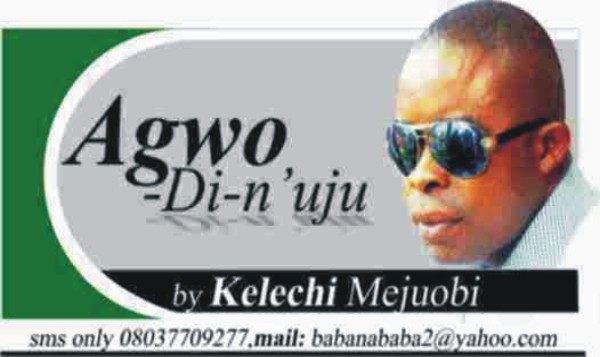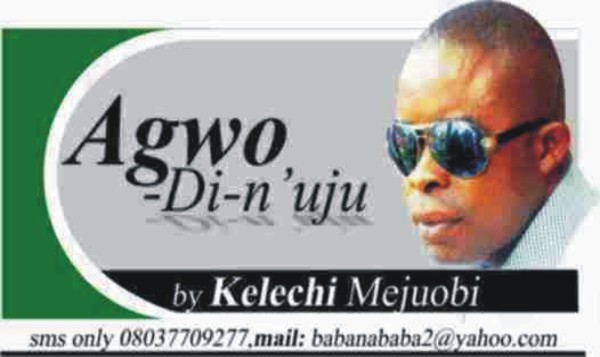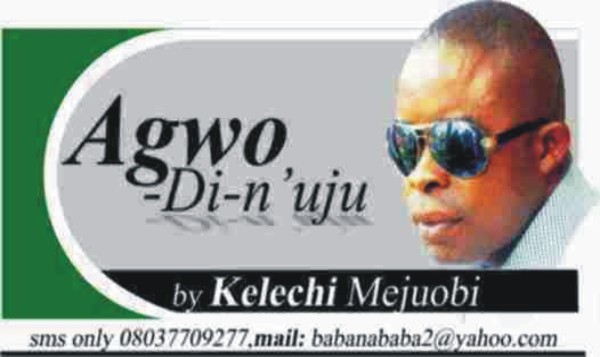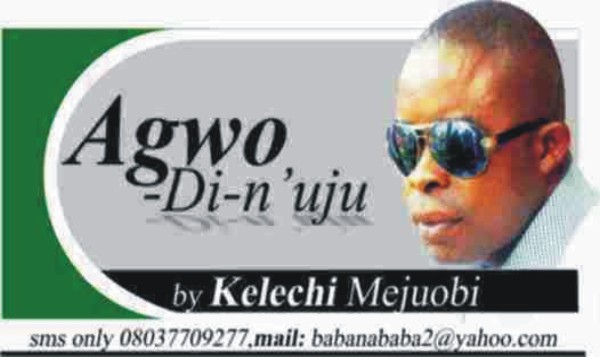This regular chorus from the outward loud speakers of mobile marketers in Owerri and environs has become a common feature of Imo State, fondly called the Eastern Heartland.
Agnes Nwamma is a popular herbal medicine for teeth cleaning. The itinerant peddlers do not have shop outlets to market the drugs than habitual movement from one location to another. In Owerri, the state capital and indeed other parts of the state, the Agnes Nwamma canvassers are well known and their signature tone to attract regular buyers is “abula ya abu, o ga eruta onye obula” ( don’t rush it, because it will reach everyone)
Ironically, apart from becoming a trademark to market the powder- like teeth cleaning herbal medicine, Imolites have likened the Urban Renewal programs of the present administration in Imo State to the “Agnes Nwamma” slogan of “abula ya abu, o ga erute onye obula” (don’t rush it, it will get to everyone ”
The Agnes Nwamma canvassers may have Okorocha’s administration in mind when it came up with the alluring slogan. It is no longer news that the Oga erute Onyeobula signature tune is synonymous to the Urban Renewal in the state capital where all sectors have had a feel of the program that has seen bulldozers destroy economic generating outfits of residents of the state capital.
Owerre spelt and pronounced as Owerri due to the influence of the colonial masters, is the state capital and the largest city in Imo State. The Owerri Township spreads across the three LGAs of Owerri Municipal, Owerri North, Owerri West and to an extent neighbouring Mbaitoli.
Records have it that the colonial masters who stepped into the town and the subsequent administrations developed a master plan for the city. All developments in Owerri before now have been tailored to correspond with the laid out plan, until the present administration came to disrupt it under what the governor tagged “Urban Renewal”
Signs that Owerri would wear a different look before or at the end of the Rochas Okorocha administration emerged earlier when it announced desire to alter the Owerri master plan. The disruption unarguably has brought hardship to the people with every sector having a sorry tale to tell.
In April 2013, the then Commissioner for Land, Survey and Urban Development, now a guber hopeful, Uche Nwosu, stated that the Okorocha government had concluded plans to review the Owerri Master plan to ensure the capital city wears a new look and check further abuses. Nwosu made the disclosure when members of the Nigeria Institute of Town Planners, Imo State visited him in Owerri.
Before the Okorocha government came up with the thought of changes of the Owerri master plan, his predecessor, Ikedi Ohakim had conceived the idea. A former commissioner who served the Ohakim government and in charge of Information and Strategy, Chuma Nnaji said that the Master Plan was being reviewed by the same Swiss firm that designed it more than 40 years ago. Ohakim’s decision was made to the State Council of Elders in Owerri through Nnaji.
In the case of Ohakim, Owerri witnessed the Clean and Green revolution, Dualization of two major roads; the Okigwe – Orji road, the Fire Service- Egbu Road and the construction of internal roads like the strategic Yar Adua Drive ( a bye pass from Porthacourt Road to Onitsha Road). The hallmark of Ohakim’s rediscovery of Owerri was the planting of grasses and ornamental flowers on major ways for beautification. Street lights and walk ways for pedestrian were also part of the Clean and Green initiatives warranting it to compete with others as the most beautiful state capital in Nigeria, before the Okorocha’s regime stepped in. Worthy of note is Ohakim’s finesse in control of water flow to avert flood in Owerri.
The structure of Owerri indicates that it lies on a low level surrounded by hills, leading to inflow of flood onto it which empties at the Nworie and Otamiri Rivers. Because of the Ugwu Orji on Okigwe-Orji road, Ugwu Ekewema on Egbu/Mbaise Road, Control/Assumpta Avenue Hill and that of the Nekede Old Road, the original Man-Holes designed in the original Owerri Master Plan was improved upon to transport water from these high points into municipality are the surrounding Nworie and Otamiri Rivers that enabled zero flood situation in the township. One giant stride that cannot be ignored during Ohakim’s tenure was opening of the Imo Interconnectivity Roads, meant to decongest traffic flow in Owerri town. The Interconnectivity Roads are the major roads surrounding Owerri town with capacity to act as bye pass without disrupting internal movement networks.
Apart from the Onitsha Road to Umuaka Orlu road meant to cut off Owerri for those moving to Orlu from Onitsha end, Ohakim started the Attah junction on Okigwe road to Inyishi, Amaimo, Ikeduru LGA enroute Obohia-Afor Oru, Afor Ogbe in Ahiazu Mbaise LGA road projects. Other bye- pass roads the immediate past governor touched briefly as access road includes for motorists to cut off Owerri the Naze Junction on Aba road to Road Safety junction crossing over to Toronto in Uratta and scheduled for Orji all in Owerri North LGA.
Part of Ohakim’s desire to decongest Owerri was the construction of a flyover from Onitsha Road through Egbeada to Amakohia and Ugwu Orji on Okigwe Road handled by Reynolds, a Construction firm with known identity.
The coming of Okorocha saw to the end of the extension of the dualization of the Okigwe road to Orji as work couldn’t go beyond the point Ohakim stopped seven years ago. Same for Egbu road as Okorocha embarked on expansion of the dualised road instead of extension into Egbu, Awaka and Emekuku towns, a suburb of the state capital and within the catchment of the Owerri Capital Development Authority, OCDA. The flyovers didn’t far better either. Incidentally, with Okorocha having about nine months to quit office, it remains doubtful if the first ever Flyover project conceived by his predecessor, Ohakim will be a reality considering the factors militating against the project. It’s worthy to note that while verifiable names like Reynolds, Coduc and Zerock handled majority of roads constructed during Ohakim era, no identifiable firm is reportedly behind the Okorocha projects. One is not surprised that the Amakohia and Orji Flyover has been described as a “waiting disaster” by the Council of Registered Engineers of Nigeria, COREN, no thanks to the unknown identity of the present contractor.
It won’t amount to an exaggeration to explain that the Urban Renewal program of Okorocha government is neither planned nor targeted at making life better for the residents of the state capital. While haters of the governor will not help but appreciate that the Okorocha Rescue Mission opened more roads, it is evidently clear that the road projects do not last, no thanks to poor quality jobs and half baked contractors assigned to handle the roads. No design and feasibility studies to weigh its effects on the people if its devastating effects are considered. Suffice it to note that during the first tenure of Okorocha, a firm known as Roche engaged in the covering of the gutters in Owerri town with slabs. In the process, all appendages of the previous administration, especially, the grasses and trees on the road side meant to provide shades to pedestrian planted by the Ohakim government, were destroyed. The world class demarcation blocks used for the dualized Orlu, Okigwe and Egbu roads were removed by the Roche group and carted away to unknown destination and brought in poorly designed kerbs. That was the beginning of demolitions in Owerri town by the present government in the guise of Urban Renewal.
The first set of persons that had a bitter pill of the Okorocha’s Urban Renewal program were the Tricycle Operators otherwise known as the Keke Riders. Before now, Keke remained the stable means of transport in Owerri Municipality. Recall that Ohakim in 2008 banned Motorcycle operators and introduced Keke. Part of those that heralded the desire of Okorocha to become the Imo State governor in 2011 were the Keke operators who led his campaign team and contributed money for his election. After the governor’s first tenure, first victim of his second missionary journey in Govt House were the Keke Operators who were flushed out of Owerri township in the spirit of Imo My Pride; the forerunner of the Urban Renewal program. Street traders followed suit and that began the story of Agnes Nwammma and “Onye abula ya abu” mantra. Street trading has been a part of Owerri feature until the Okorocha government cut them into size and used all machineries to ban them on the streets.
Next was the turn of traders and artisans in various parts of the state capital beginning with those at the Orji Mechanic Village in Owerri North. After those of Orji were forcefully removed and their property destroyed, it became the turn of traders at the popular Eke Ukwu Owerri market in the heart of the town. Okorocha braced all odds to demolish the market in August 2017 but not without witnessing a casualty in the person of Somtochukwu, a 10-yr old boy who died in the process the death of Somtochukwu may not be unconnected to the presence of armed security agencies who accompanied the government bulldozers to rubbish the once sprawling market located on Douglas Road.
New Market on the same Douglas Road the traditional domain of Motor Spare parts dealers including the Nekede Mechanic village were not also left out in the operation demolish all markets in Owerri, by the Okorocha government in the guise of Urban Renewal. It also touched business operators on the four major roads in the state capital; Assumpta Avenue, Douglas Road, Whetheral and Okigwe road as Government chopped off vital aspect of their shops in a bid to undertake the expansion of the roads. Remarkably, with not more than 8 months left for Okorocha to vacate Government House, the entire state capital is a huge construction site thereby making the residents uncomfortable. Part 2 continues next week.









